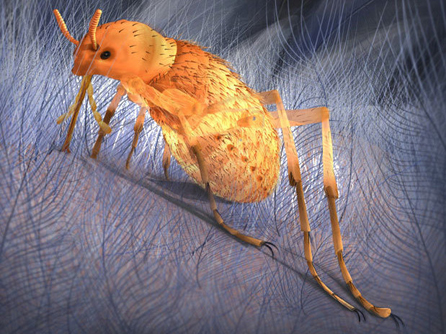Giant Fleas “Bugged” the Dinosaurs According to New Research
Chinese Palaeontologists Identify Mesozoic Parasites that Plagued the Dinosaurs
A team of scientists have been busy studying the remains of ancient pseudo-fleas preserved in amber that would have made dinosaur lives a misery back in the Cretaceous. Giant fleas may have pestered dinosaurs. Amber is fossilised tree resin. It is produced by certain types of trees to help seal wounds on the tree and to protect against disease, the sticky substance traps organisms which when the resin hardens into amber are preserved as fossils.
Giant Fleas
Researchers in China have named and described two primitive flea-like insects that probably fed on the blood of dinosaurs, their large size, several times the size of extant fleas that plague mammals today, indicates that even the biggest dinosaur may have been pestered by these Cretaceous critters. The two types of blood sucker, assigned to the same genus have been named Pseudopulex jurassicus and Pseudopulex magnus.
Commenting on the recent discoveries of large parasites that fed on dinosaurs and other reptiles, zoologist George Poinar Junior of Oregon State University stated:
“They have this large beak. Oh, it looks horrible. It looks like a syringe when you go to the doctor to get a shot or something.”
Emeritus professor Poinar, specialises in analysing and examining the preserved remains of insects that have been preserved in amber. He regards these insects as pseudo-fleas, they are similar to modern-day fleas but sufficiently different to be distinguished from extant genera. The legs for example are much longer, they are not designed for jumping, but perhaps these large bugs were able to use their long legs to latch onto and secure themselves to the hides of passing dinosaurs. The long, beak-like proboscis could then be used to probe between the scales to tap into blood running just underneath the skin.
Giant Mesozoic Parasites of Dinosaurs
Picture credit: Wang Cheng/Journal of Current Biology
A number of dinosaur parasites have been discovered and described over the last couple of months. In March, Everything Dinosaur team members reported on some further Chinese research concerning the fossilised remains of huge insects that had probably “bugged” dinosaurs.
To read more about the recent Chinese discoveries: Giant Fleas from the Age of Dinosaurs.
With work published in the scientific journal “Current Biology”, Poinar went onto to speculate how the evolution of many different types of insect during the Mesozoic changed the world in which the dinosaurs lived. He went onto explain that insects from the Late Jurassic onwards probably had a huge impact in at least two ways. Firstly, insects such as beetles were pollinators, and they encouraged the evolution of Angiosperms (flowering plants). This may have affected dinosaur evolution with the ornithischians emerging as the dominant plant-eating dinosaurs in the latter part of the Mesozoic. Other types of dinosaur, ones that could not adapt to the changing fauna would have become vulnerable to extinction.
To view models and figures of prehistoric animals including dinosaurs: Prehistoric Animal and Dinosaur Models.
Secondly, as Poinar points out, dinosaurs had diseases, parasites and intestinal worms. They probably got some of these conditions from insects such as these primitive flea-like creatures. The evolution of many new types of parasite could have weakened the dinosaur genetic pool, thus adding to the woes of the Dinosauria.
Poinar went onto add:
“To a lot of them [the dinosaurs], this was something brand new they hadn’t been exposed to before and it would have decimated the population. And it wasn’t just one disease but a combination of diseases.”
Parasites of the Dinosaurs
Parasites such as these super-sized fleas could have played a role in the extinction of the dinosaurs.
A number of studies have been carried out recently looking into how the Order Insecta diversified during the Age of Reptiles. In one recent study, scientists looked at how biting lice that today “bug” birds became more diverse, probably as a result of feeding on feathered and non-feathered members of the Dinosauria. It seems that one of the drawbacks of the short arms on theropod dinosaurs was that they could not scratch themselves very effectively. How these animals coped with the irritation caused by these parasites can only be speculated upon – T. rex having a favourite scratching post perhaps?
To read more about other parasites affecting the dinosaurs: The Tree of “Lice” – parasites of the dinosaurs.


